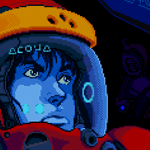|
A couple of days ago I stumbled upon videos of Euclidean's Unlimited engine. For the unfamiliar, it's a 3D graphics engine that uses a 'point cloud' rather than polygons. A point cloud is more or less what it sounds like - 3D images are built up from a series of points in 3D space, the points having been created using laser scans of the real world (though you can convert existing 3D polygon libraries as well). Euclidean have developed an indexing system that renders only the relevant points (i.e. the visible ones) and it's an order of magnitude faster than existing systems - smooth enough for real-time rendering at a playable speed. Whether this tech will be used for games is debateable, but that video turned something that has been nagging at the back of mind into something more fully formed. Just how much longer can we rely on polygons for 3D rendering? The history of 3D graphics starts with vectors. The games you see today are essentially using a whole heap of stuff bolted onto that concept. Start with lines drawn between points in 3D space. Cull anything that's facing away from the camera to simulate surfaces. Fill those surfaces with colour and light them. Texture those surfaces. Simulate further detail on those textures using shaders to approximate lighting and parallax. Each of those iterative steps were developed before the processing power was available to render them in real-time, as opposed to rendering frame-by frame into moving images - think Toy Story vs the real-time games around in the late 90s. The techniques that are available in pre-rendered animation at least partially drive the need for MORE GRAPHIKS in games. 'Texture mapping has been invented - how can I get this into my game'? The answer for real-time graphics is to cull like your life depends on it. Cull back faces, cull things that are far away, reduce the texture resolution and tessellation for distant objects, partially load your map, etc, anything that means your GPU has less work to do. John Carmack led the way with the concept of culling in games with Doom, where he used binary space partitioning to work out what parts of the level and image needed to be rendered. As a programmer this never sat right with me. Theses are 'work-arounds'. These are writing extra bits of code around the limitations of your system, where the preference is always to come up with an elegant solution in the first place. Euclidean's system, now the processing power is available, seems far more elegant than the multitude of culling techniques we're currently using. What rammed it home for me was the woodland scene and the doorway scene from the first video I posted. If realism is what polygon engine designers are working towards, images like those are surely what they're aiming for. Yet how much work would it be for both the engine designer and the artist to create those scenes using polygons and shaders and lord knows what else bolted onto vectors? At what point do we draw the line and say 'this isn't worth the effort'? When we've spent a year developing an engine that allows enough polygons to simulate a rough edge on a wall, or slightly off-square tiles? When we've spent 6 months rendering unique trees with unique bark textures for a woodland scene that you spend 2 minutes walking through? Sure, we have incredible detail in CG movies, but those are scripted. The artist doesn't have to worry about drawing trees if he knows the camera is never going to go into the forest. I'm starting to feel like something is going to give. The power might be there, but flawlessly realistic scenes in games using techniques built on the current toolset just won't be worth the human effort or the financial return. Personally I envisage a system like Unlimited, where games are built up from 'sets' and objects scanned from the real word. Not only will this be quicker and cheaper than building entire worlds out of shapes, it will look better. Alternatively, we'll carry on using polygons, but the majority of games will use bought assets as they don't have the time to create their own (similar to how games now will use 3rd party engines like Unreal). Fake edit: This discussion is not about how good or not the Euclidean video looks! Fake edit II: Post also inspired by this story about the glithces in the new Assisins Creed game. They look to me like errors in culling (e.g. the hilarious kiss pic, where the engine is culling that poor man's face). Are these errors a result of an over-complicated engine that is doing too much culling work? EvilGenius fucked around with this message at 13:11 on Nov 14, 2014 |
|
|
|

|
| # ? Apr 23, 2024 16:43 |
|
EvilGenius posted:A couple of days ago I stumbled upon videos of Euclidean's Unlimited engine.
|
|
|
|
Are voxels also dead?
|
|
|
|
|
RHOKiT1 month ago nearly started crying when i saw this this is an amazing upgrade from old engines just INCREDIBLE Reply · 6  jesus loving christ nerds are the worst jesus loving christ nerds are the worst
|
|
|
|
Looks pretty drat cool as a proof of concept video.
|
|
|
|
Impressive pop-in and vertical tearing, it really will be a perfect stand-in for current 3D engines.
|
|
|
|
You'll take my polygons from my cold, dead hands.
|
|
|
|
Interesting, but I can't help but feel like I'm just looking at a prettier version of those old magic eye pictures.
|
|
|
|
Ninja fetus posted:Holy hell this looks like something out of a mushroomtrip. So did voxels(actual ones, not minecraft cubes), although in some cases it can't be attributed entirely to graphics technology https://www.youtube.com/watch?v=wobNQOl6KHA
|
|
|
|
quote:I'm starting to feel like something is going to give. The power might be there, but flawlessly realistic scenes in games using techniques built on the current toolset just won't be worth the human effort or the financial return. Personally I envisage a system like Unlimited, where games are built up from 'sets' and objects scanned from the real word. Not only will this be quicker and cheaper than building entire worlds out of shapes, it will look better. Alternatively, we'll carry on using polygons, but the majority of games will use bought assets as they don't have the time to create their own (similar to how games now will use 3rd party engines like Unreal). If having a church in a videogame means we have to build and scan a church in the real world, I have no clue why you think this will be quicker and cheaper than handling a 3D artist some 3D modelling software. As a programmer, polygons might seem kludgy to you, but to artists it's something that works, so I don't see why polygon based frameworks will ever be replaced given you have a population of asset creators at this point for whom it's natural and what they've been trained on. I think we've essentially already pretty much reached the endstate of the race for 'realistic graphics'. Fangz fucked around with this message at 15:40 on Nov 14, 2014 |
|
|
|
Fangz posted:I think we've essentially already pretty much reached the endstate of the race for 'realistic graphics'. This has been said so many times over the years. And like in those cases, 10 years from now we'll look back and think "drat, those 2014 graphics sure seem gludgy now". EDIT: One of the earlier demos for this tech said that the advantage of the point cloud-thing is how well it runs. Being able to run graphics like those in the demo on a mid-range PC would be pretty groundbreaking, but then again, it's just their word at this point so I'm not holding my breath. Give us a demo we can run on our 'puters and we'll see. Dropbear fucked around with this message at 15:50 on Nov 14, 2014 |
|
|
|
Fangz posted:If having a church in a videogame means we have to build and scan a church in the real world, I have no clue why you think this will be quicker and cheaper than handling a 3D artist some 3D modelling software. Honestly anything that improves the way artists can capture an environment or design is a good tool. Also they show the scope quite large in the video but you could scan smaller objects that you need like a pencil or a cup or chair.
|
|
|
|
Prefab assets are nothing new. One of the very cool things about polygons is that the same prefab cup or pencil can be used a million different ways, modified constantly to fit whatever needs they have, or whatever. I'm not sure if the tech would allow constant modifications or whatever. If you want a different cup from the cup that has been scanned, do you have to scan a different cup? Isn't that literally creating twice as much work for something that would be a small job by a competent 3D modeller in an existing software suite.
|
|
|
|
Ddraig posted:Prefab assets are nothing new. One of the very cool things about polygons is that the same prefab cup or pencil can be used a million different ways, modified constantly to fit whatever needs they have, or whatever. At least in the previous video they said you can use a plugin or something to turn 3d-models from at least the most common modeling programs into point clouds, so if they aren't full of poo poo I'd assume you can reverse this as well and fiddle with your object as you please. Personally I'm more interested in the point clouds' realtime performance than the real-world scanning support.
|
|
|
|
^^^ yes, perhaps I put too much emphasis on the scanning. The point cloud tech just means you can have unlimited detail, hence the name, however your objects are created. Having said that:Fangz posted:If having a church in a videogame means we have to build and scan a church in the real world, I have no clue why you think this will be quicker and cheaper than handling a 3D artist some 3D modelling software. The Euclidean video suggests otherwise. Games still look like games. They still look like perfectly lit origami worlds and people. I think we're a long way off looking like you're walking round in a photo, and I don't think we'll ever get there with polygons. Also, having a church in a movie means either finding a real one or building a set. With the amount of time and money publishers are currently splashing on games, is it so far fetched? When that can be done, how are artists with their polygons ever going to compete? How much do you think it cost to scan that church, vs paying an artist to build in that level of detail, cos actually I'm thinking there wasn't much in it. EvilGenius fucked around with this message at 16:23 on Nov 14, 2014 |
|
|
|
EvilGenius posted:^^^ yes, perhaps I put too much emphasis on the scanning. The point cloud tech just means you can have unlimited detail, hence the name, however your objects are created. Having said that: Building a set could be as simple physically modeling a scaled setting, sounds a lot like what old movie effects did.
|
|
|
|
Animation in a point cloud method is going to be orders of magnitude harder than with polygons. There is a reason why its being shown with static objects or locations. Also point clouds are going to need orders of magnitude more storage space (and memory) as well. Both of which probably mean it will be a long time before we see games using them. edit: Also it doesn't mean you can have "unlimited detail", its bounded by the density of the sampled points for the point cloud. Its like saying a digital image has "unlimited detail" . edit 2: The comparison to voxels is quite apt. Its just voxels at a high resolution Billy Gnosis fucked around with this message at 16:29 on Nov 14, 2014 |
|
|
|
There is a nice middle ground you can hit, where you create assets using photogrammetry and pointclouds, then retopologize into polys using the pointcloud as a base mesh. You get the benefit of not needing to do custom texture work, while still having a reasonable polygon mesh you can move around as you please. The Vanishing of Ethan Carter used this extensively, and they have a blog post talking about the process with samples here.
|
|
|
|
|
Billy Gnosis posted:Animation in a point cloud method is going to be orders of magnitude harder than with polygons. There is a reason why its being shown with static objects or locations. Also point clouds are going to need orders of magnitude more storage space as well. Both of which probably mean it will be a long time before we see games using them. Oh, it is flawed tech and there are some gaps - animation and storage, as you say, are going to be issues. And what about dynamic lighting and shadows? My point was more that it takes something drastically different to polygons to produce photographic levels of detail.
|
|
|
|
EvilGenius posted:Oh, it is flawed tech and there are some gaps - animation and storage, as you say, are going to be issues. And what about dynamic lighting and shadows? Its not my background, but I don't see dynamic lighting and shadows being any easier (probably much much, harder) since you aren't dealing with surfaces any more, but arbitrary points. If anything going from point cloud capturing of real objects -> really nice and complicated polygonal approximations for games / movies is where it could be used. Billy Gnosis fucked around with this message at 16:33 on Nov 14, 2014 |
|
|
|
Billy Gnosis posted:edit: Also it doesn't mean you can have "unlimited detail", its bounded by the density of the sampled points for the point cloud. Its like saying a digital image has "unlimited detail" . The 'unlimited' comes from the fact that the renderer is not impacted by the number of points. You can keep adding detail at the macro or micro scale without any drop in frame rate, because all you're doing is running the same indexing algorithm and displaying the same number of points on the screen. Voxels have a volume, whearas points don't. Think medical imaging, where you can slice through a scan and see what's inside it. Points render the surface only. Billy Gnosis posted:Its not my background, but I don't see dynamic lighting and shadows being any easier (probably much much, harder) since you aren't dealing with surfaces any more, but arbitrary points. That's what I meant - with real world scans you're capturing the lighting at the time of the scan. You can no more change that than you can change the lighting in a photograph. EvilGenius fucked around with this message at 16:41 on Nov 14, 2014 |
|
|
|
This plus oculus rift sounds like fun.
|
|
|
|
Yet another worthless gimmick. The laser scanning + photography used to create this is already being used to create content for games, but not as point clouds. In every use of the data, it's converted to a traditional polygonal form.
|
|
|
|
This is a scam and everyone taking it seriously after all these years needs to get their brain checked.
|
|
|
|
|
Point cloud is next gen
|
|
|
|
EvilGenius posted:The 'unlimited' comes from the fact that the renderer is not impacted by the number of points. You can keep adding detail at the macro or micro scale without any drop in frame rate, because all you're doing is running the same indexing algorithm and displaying the same number of points on the screen. Only in the same sense that you could say that an environment of polygons could have unlimited detail. The indexing algorithm is quite similar to occlusion methods. Even more so that implies you actually have the capturing technology to go deeper and deeper in detail, which isn't the case (And stored deeper and deeper amounts of points ahead of time. That's going to be a storage and ram nightmare). It doesn't matter that voxels have volume, what I meant was the point cloud is literally a set of data containing position (x,y,z) i have color C for each point. Which is similar to voxels except voxels traditionally work in a fixed grid. To have a convincing surface with a point cloud you need to have these points have "volume" as well. This is all sidestepping the issue that capturing that church (for instance) took way more resources and man hours than modeling a convincing church. Billy Gnosis fucked around with this message at 17:29 on Nov 14, 2014 |
|
|
Jesustheastronaut! posted:Point cloud is next gen
|
|
|
|
|
Ddraig posted:Prefab assets are nothing new. One of the very cool things about polygons is that the same prefab cup or pencil can be used a million different ways, modified constantly to fit whatever needs they have, or whatever.
|
|
|
|
Anyway, read the OP guys, this thread isn't about Euclidean. From what I hear they're actually trying to flog their engine to the geo tech industry now anyway. poo poo, maybe it is a scam, but it's not the point. The point is, polygons are never going to be practical for true photo realism. Vvv once they crack boob physics, they'll crack the industry. EvilGenius fucked around with this message at 18:10 on Nov 14, 2014 |
|
|
|
I do a lot of work with GIS software suites and can confirm that Euclidean is indeed hawking its stuff out to those of us in the geotech industry. That being said it'll be a good day when we get even more realistic video game titties.
|
|
|
EvilGenius posted:The point is, polygons are never going to be practical for true photo realism.
|
|
|
|
|
I am also certain you are ignoring the extent to which current developers employ scanning.
|
|
|
|
|
Sorry, realtime photorealism. Amazing film tho.
|
|
|
EvilGenius posted:Sorry, realtime photorealism.
|
|
|
|
|
Great Joe posted:I doubt simulations concerning geotech are actually performed in real-time, though I'd rather Widestancer tell us about that. I can't find it right now, but there's a whole Euclidean presentation on existing GIS point cloud visualisers, and they were hilariously basic. That may not even be an issue in the industry, but I thought it was almost comical that in order to get smooth camera movement, one of the engines just removes 90% of the points from existence until the camera is stationary again. Load time was an issue with a lot of them too.
|
|
|
EvilGenius posted:I can't find it right now, but there's a whole Euclidean presentation on existing GIS point cloud visualisers, and they were hilariously basic. That may not even be an issue in the industry, but I thought it was almost comical that in order to get smooth camera movement, one of the engines just removes 90% of the points from existence until the camera is stationary again. Load time was an issue with a lot of them too.
|
|
|
|
|
How long does it take to make a good polygon asset? Does it take the same time today to do a good polygon asset as it did 5 years ago? I don't know much about the game art industry, but I don't think any technology that takes much more time to make good assets will pick up. Can you make that Euclidean art quickly or do you really need to scan it in?
|
|
|
|
I will enjoy this engine when it is added to Google Earth and I can feel like I'm really walking on streets, OP.
|
|
|
|
These guys make a video every few years, promise they're changing the industry, and then disappear. I think they're just a scam, really, rather than anything ground breaking. (Which by now we'd have seen something more than their own horn tooting press releases.) edit: And as to culling being a work around, welp, can't say much to that, except the most powerful visual computer to date culls and makes up so much stuff that almost everything it see's is an illusion. It's efficient. There's no drat reason to display things that you can't see, or have high resolution textures where they'd never get displayed on the monitor. Probably a better way of looking at it is that we do all these tricks to make the system work and run well, right? Well, what makes you think that a more detailed system is going to run better? Its a pretty simple math problem at it's base. The more information you display the more power you need. Since we have only so much power available we have to cull something, no mater what sort of system you use. You have a hard limit to the amount of information you can display. So any sort of scheme, be it floating points or volumetric whatevers, or polygons is going to have some set of bugs caused by culling as we try and squeeze as much data as possible into our scenes. The second concern is how we custom tailor our hardware. You talk about wasted hours trying to kludge a system to look good in polygons, but that's what we build our processors to make. You change the underlying math and you need to change the entire hardware industry. Or just use the general processing power of the CPU, which means you'll need to find more work arounds. There's nothing particularly inelegant about polygons. They're nice shapes and they're easy to do math with. We've got what? A few decades now of hardware momentum behind using them. It takes a hell of a lot more effort, time, money, and raw resources to redo and disseminate some new GPU set up than it does to keep on coming up with software tricks. Inertia alone means polygons will stay for a loooong time. Killer-of-Lawyers fucked around with this message at 12:05 on Nov 15, 2014 |
|
|
|

|
| # ? Apr 23, 2024 16:43 |
|
Great Joe posted:This is a scam and everyone taking it seriously after all these years needs to get their brain checked. Why did it take so long for this to come up?
|
|
|





























